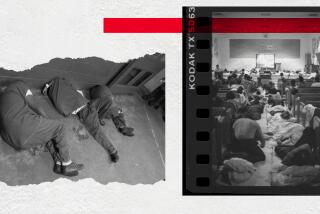Hoping Clothes Make the Man Look Innocent
- Share via
You are sitting in a jury box in downtown Los Angeles and in walks a handcuffed prisoner, slouching toward his lawyer’s table wearing his prison blues. It’s the same freeze-frame snatched from thousands of courtrooms across the country.
But take that same prisoner and deck him out in a nicely dry-cleaned three-piece suit and he looks less like a criminal.
Both defense lawyers and ex-jurors have said that the clothes a defendant wears in court can make the difference between a prison stretch and going free.
During last year’s O.J. Simpson double murder trial, hundreds of reporters discussed how Simpson’s expensive suits may have played an important role in increasing his respectability and image with jurors. So why did Simpson get to wear his suits when the average prisoner usually sports those ugly blue or orange jumpsuits?
Law enforcement officials say Simpson is a poor example of the process.
“His case was nothing like what our normal procedures are,” said Sheriff’s Deputy Robert Stoneman.
In Simpson’s case, his lawyers were allowed, with court approval, to bring fresh clothing to the courthouse each day from his home--a privilege not granted most other prisoners.
If a not-so-famous prisoner wants to wear his or her own clothes on trial, the defense lawyer must petition the judge to allow the defendant to wear those clothes.
Family members must bring an outfit to the jail, where the clothes are booked in and checked by sheriff’s deputies. The clothes travel in a bag on a bus with the inmate to the courthouse, where the inmate can change into them before entering the courtroom.
The clothes a prisoner wore when he or she was arrested are stored and cannot be used until the prisoner is released.
Law enforcement officials say prisoners try to wear clothes in which they are comfortable. But because the prison population represents such a diverse cross-section of Los Angeles, including gang members and skinheads, authorities are reluctant to allow prisoners to wear clothing that may be interpreted as gang attire or which conveys a controversial message.
“The judges have certain rules about what’s appropriate courtroom attire,” Stoneman said. “Obviously, there are certain rules, like no hats or shorts allowed, that everyone has to follow.”
In the past, many prisoners were not savvy enough to understand what a big difference clothes can make. High-profile cases of defendants such as Simpson and the Menendez brothers have changed that.
“There is an extensive communication system in the jails,” Stoneman said. “So I’m pretty sure they know [now] about how things like this can help them.”
Otherwise it’s the sheriff’s jumpsuit.
Although orange and blue suits are most common, there are jumpsuits of many colors. The color coding conveys information to deputies guarding the prisoners, such as whether the prisoner has special medical needs or needs higher security. The Sheriff’s Department does not publicize what the colors mean, to keep potential jurors from prejudging defendants, said Deputy Jim Hellmold.
“The only thing that I can say is that dark blue jumpsuits always are worn at a presentencing hearing and light green is for sentencing,” Hellmold said.
More to Read
Sign up for Essential California
The most important California stories and recommendations in your inbox every morning.
You may occasionally receive promotional content from the Los Angeles Times.













